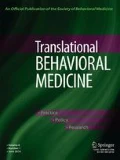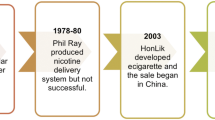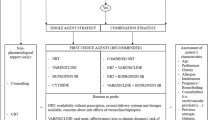Abstract
Online tobacco cessation communities are beneficial but underused. Our study examined whether, among smokers participating in a web-assisted tobacco intervention (Decide2quit.org), specific characteristics were associated with navigating to BecomeAnEx.org, an online cessation community, and with subsequent quit rates. Among smokers (N = 759) registered with Decide2quit.org, we identified visitors to BecomeAnEx.org, examining associations between smoker characteristics and likelihood of visiting. We then tested for associations between visits and 6-month cessation (point prevalence). We also tested for an interaction between use of other online support-seeking (Decide2quit.org tobacco cessation coaches), visiting, and 6-month cessation. One quarter (26.0 %; n = 197) of the smokers visited BecomeAnEx.org; less than one tenth (7.5 %; n = 57) registered to participate in the online forum. Visitors were more likely to be female (73.0 vs. 62.6 % of non-visitors, P < 0.01) to have visited a cessation website before (33.0 vs. 17.4 %, P < 0.01) and to report quit attempts in the previous year (62.0 vs. 53.0 %, P = 0.03). In analyses of all participants, BecomeAnEx.org visiting was not associated with 6-month quit completion. Among participants who communicated with a coach, BecomeAnEx.org visiting also lacked a significant association with 6 month quit completion, although a non-significant trend toward quit completion in visitors was noted (OR 2.21, 95 % CI 0.81–3.1). Online cessation communities attract smokers with previous cessation website experience and recent quit attempts. Community visiting was not associated with quit rates in our study, but low use may have limited our power to detect differences. Further research should explore whether an additive effect can be achieved by offering community visitors support via online coaches.

Similar content being viewed by others
References
Services, U.S.D.o.H.a.H., The health consequences of smoking—50 years of progress. Centers for Disease Control and Prevention 2014. http://www.surgeongeneral.gov/library/reports/50-years-of-progress/full-report.pdf. Accessed May 30, 2014
NIH State-of-the-Science Conference Statement on Tobacco Use. Prevention, cessation, and control. NIH Consens State Sci Statements. 2006; 23(3): 1-26.
Sadasivam RS et al. Internet health information seeking is a team sport: analysis of the Pew Internet Survey. Int J Med Inform. 2013; 82(3): 193-200.
Cutrona SL et al. Adult willingness to use email and social media for peer-to-peer cancer screening communication: quantitative interview study. JMIR Res Protoc. 2013; 2(2), E52.
Cobb NK, Graham AL, Abrams DB. Social network structure of a large online community for smoking cessation. Am J Public Health. 2010; 100(7): 1282-9.
Cobb NK et al. Online social networks and smoking cessation: a scientific research agenda. J Med Internet Res. 2011; 13(4), e119.
Cobb NK, Graham AL. Health behavior interventions in the age of facebook. Am J Prev Med. 2012; 43(5): 571-2.
Cobb NK, Saul JM, Wileyto EP, Graham AL. Diffusion of an evidence-based smoking cessation intervention through Facebook: a randomised controlled trial study protocol. BMJ Open. 2014; 4(1), e004089.
Hesse BW, et al. Realizing the promise of Web 2.0: engaging community intelligence. J Health Commun, 2011. 16 Suppl 1: 10–31.
Loss J, Lindacher V, Curbach J. Online social networking sites—a novel setting for health promotion? Health Place. 2014; 26: 161-70.
Maher CA, Lewis LK, Ferrar K, Marshall S, De Bourdeaudhuij I, Vandelanotte C. Are health behavior change interventions that use online social networks effective? A systematic review. J Med Internet Res. 2014; 16(2), e40.
Ancker JS et al. Peer-to-peer communication, cancer prevention, and the internet. J Health Commun. 2009; 14(Suppl 1): 38-46.
A clinical practice guideline for treating tobacco use and dependence: A US Public Health Service report. The tobacco use and dependence clinical practice guideline panel, staff, and consortium representatives. JAMA. 2000; 283(4): 3244-54.
Eysenbach G, Powell J, Englesakis M, Rizo C, Stern A. Health related virtual communities and electronic support groups: systematic review of the effects of online peer to peer interactions. BMJ, 2004. 328(7449)
Frost JH, Massagli MP. Social uses of personal health information within PatientsLikeMe, an online patient community: what can happen when patients have access to one another’s data. J Med Internet Res, 2008. 10(3)
McCausland KL, Curry LE, Mushro A, Carothers S, Xiao H, Vallone DM. Promoting a Web-based smoking cessation intervention: implications for practice. Cases in Public Health Communication & Marketing. 2011; 5: 3-26.
Bock BC et al. A review of web-assisted tobacco interventions (WATIs). J Med Internet Res. 2008; 10(5), e39.
Houston TK, Ford DE. A tailored Internet-delivered intervention for smoking cessation designed to encourage social support and treatment seeking: usability testing and user tracing. Inform Health Soc Care. 2008; 33(1): 5-19.
Houston TK et al. The QUIT-PRIMO provider-patient Internet-delivered smoking cessation referral intervention: a cluster-randomized comparative effectiveness trial: study protocol. Implement Sci. 2010; 5: 87.
Sadasivam RS et al. Development of an interactive, Web-delivered system to increase provider-patient engagement in smoking cessation. J Med Internet Res. 2011; 13(4), e87.
Sadasivam RS et al. Who participates in Web-assisted tobacco interventions? The QUIT-PRIMO and National Dental Practice-Based Research Network Hi-Quit studies. J Med Internet Res. 2013; 15(5), e77.
Gilbert GH, Williams OD, Rindal DB, Pihlstrom DJ, Benjamin PL, Wallace MC. DPBRN Collaborative Group. The creation and development of the dental practice-based research network. J Am Dent Assoc. 2008; 139(1): 74-81.
Google. webcite AdWords https://www.google.com/adwords/?sourceid=awo&subid=ww-et-awhp_nelsontest_con&clickid
Graham AL et al. Improving adherence to web-based cessation programs: a randomized controlled trial study protocol. Trials. 2013; 14: 48.
Danaher BG et al. Mediators of a successful web-based smokeless tobacco cessation program. Addiction. 2008; 103(10): 1706-1712.
Severson HH et al. ChewFree. com: evaluation of a Web-based cessation program for smokeless tobacco users. Nicotine Tob Res. 2008; 10(2): 381-391.
Danaher, Brian G., et al. "Use of non-assigned smoking cessation programs among participants of a Web-based randomized controlled trial." Journal of medical Internet research 11.2 (2009)
Etter, Jean-François. "Comparing the efficacy of two Internet-based, computer-tailored smoking cessation programs: a randomized trial." Journal of Medical Internet Research 7.1 (2005)
Hall SM, Delucchi KL, Velicer WF, et al. Statistical analysis of randomized trials in tobacco treatment: longitudinal designs with dichotomous outcomes. Nicotine Tob Res. 2001; 3(3): 193-202.
Jackson D et al. An exploration of the missing data mechanism in an Internet based smoking cessation trial. BMC Med Res Methodol. 2012; 12: 157.
Smolkowski K et al. Modeling missing binary outcome data in a successful web-based smokeless tobacco cessation program. Addiction. 2010; 105(6): 1005-15.
Forte A, Bruckman A. Why do people write for wikipedia? Incentives to contribute to open-content publishing. Proceedings of 41st Annual Hawaii International Conference on System Sciences (HICSS), 2008
Japuntich SJ, Zehner ME, Smith SS, et al. Smoking cessation via the internet: a randomized clinical trial of an internet intervention as adjuvant treatment in a smoking cessation intervention. Nicotine Tob Res. 2006; 8(Suppl 1): S59-67.
An LC, Schillo BA, Saul JE, et al. Utilization of smoking cessation informational, interactive, and online community resources as predictors of abstinence: cohort study. J Med Internet Res. 2008; 10(5): 1018.
Graham AL, Cobb NK, Raymond L, Sill S, Young J. Effectiveness of an internet-based worksite smoking cessation intervention at 12 months. J Occup Environ Med. 2007; 49(8): 821-8.
Sutter JD. Many social networkers happy just to lurk. CNN.com, 2010
Preece J, Shneiderman B. The reader-to-leader framework: motivating technology-mediated social participation. Transactions on Human-Computer Interaction. 2009; 1(1): 13-32.
Hargittai E. Whose space? Differences among users and non-users of social network sites. Journal of Computer-Mediated Communication. 2007; 13(1): 276-297.
Duggan M, Brenner J. The demographics of social media users. 2012 Pew Research Internet Project, 2013
Duggan M. It’s a woman’s (social media) world. Pew Research Internet Project, 2013 Sep 12
Christakis NA. Social networks and collateral health effects. BMJ. 2004; 329(7459): 184-5.
Hughes JR et al. Measures of abstinence in clinical trials: issues and recommendations. Nicotine Tob Res. 2003; 5(1): 13-25.
Prochaska JO. "Standardized, individualized, interactive, and personalized self-help programs for smoking cessation.". Health Psychol. 1993; 12(5): 399.
Jarvis M et al. An evaluation of the intervention against smoking in the multiple risk factor intervention trial. Prev Med. 1984; 13(5): 501-509.
Velicer WF, Prochaska JO, Rossi JS, Snow MG. Assessing outcome in smoking cessation studies. Psychol Bull. 1992; 111(1): 23-41.
Graham AL et al. A randomized trial of Internet and telephone treatment for smoking cessation. Arch Intern Med. 2011; 171(1): 46-53.
Acknowledgments
Funding for these studies was received from the National Cancer Institute, grant R01 CA129091, and the National Institute of Dental and Craniofacial Research, grants U01 DE16746, U01 DE16747, and U19 DE22516. Research reported in this publication was also supported by the National Center for Advancing Translational Sciences of the National Institutes of Health under award number UL1TR000161. Dr Sadasivam is also funded by a National Cancer Institute Career Development Award (K07CA172677). Dr. Houston is also supported by the VA eHealth Quality Enhancement Research Initiative (eHealth QUERI) that he directs. Dr. Cutrona is supported by the National Center for Research Resources at the National Institutes of Health (grant number KL2TR000160). The content is solely the responsibility of the authors and does not necessarily represent the official views of the National Institutes of Health, the Department of Veterans Affairs, or the United States government. Authors would like to thank Daniel Ford for his role in data acquisition.
Author information
Authors and Affiliations
Consortia
Corresponding author
Ethics declarations
Conflict of interest
During the study period, Dr. Cobb was employed by Legacy, a non-profit organization that owns and operates the BecomeAnEx.org website. Dr. Cutrona has received grant funding from Pfizer Independent Grants for Learning & Change.
Adherence to ethical principles
All procedures performed in studies involving human participants were in accordance with the ethical standards of the institutional and/or national research committee and with the 1964 Helsinki declaration and its later amendments or comparable ethical standards.
Additional information
Implications
Practice: Medical and behavioral practitioners who refer smokers to web-assisted tobacco interventions (WATIs) should be aware that cessation online communities (reachable through WATI links) may hold particular appeal for women aged 55 and older, for smokers with recent quit attempts, and for smokers who have prior experience with online cessation websites.
Policy: Investment in developing WATIs with links to online communities should address methods for appealing to broader audiences (e.g., those contemplating a first quit attempt and those considering online engagement in cessation activities for the first time.)
Research: Further research is needed to explore the impact of providing cessation community visitors with additional support via online coaches.
Appendices
Appendix A. Screenshot of the home page of the decide2quit.org web-assisted tobacco intervention

Functions available on the Decide2quit.org homepage included online educational content accessed via a navigation bar: Family Tools (how to get constructive help from family), Healthcare Provider Tools (how to include your healthcare provider in quit plans), The Library (cessation articles and other tools), My Health Risks (information on smoking risks, symptoms and harmful chemicals), and Thinking About Quitting (motivational recommendations, interactive calculators assessing triggers).
The Decide2Quit.org homepage highlights three main functions. The first is a motivational, pushed-email, tailored messaging system. The second is a secure asynchronous messaging with a certified tobacco cessation coach. Coaches completed the University of Massachusetts 4-day Tobacco Treatment Specialist Core Training, an intensive, evidence-based training program designed to address core competencies for tobacco treatment specialists. The third is a column entitled “Your Online Community” which provided a link to BecomeAnEx.org, a free smoking cessation website. Those who visit BecomeAnEx.org receive social support by reading blogs written by other smokers; those who register can additionally participate in an online social network by posting messages.
Appendix B. Smokers accessing a web-assisted tobacco intervention (Decide2quit.org): proportion of those with missing data at 6 month follow-up among those who do not visit an online cessation social network (BecomeAnEx.org) compared to those who visit (including Lurkers and Registrants).

Lurkers’ are smokers who clicked on the hyperlink to BecomeAnEx.org allowing them the ability to read online discussions, but not to post; “Registrants” are smokers who clicked on the hyperlink to BecomeAnEx.org and registered with the site, allowing for both reading and posting on the online social network. 95 % confidence intervals are shown.
About this article
Cite this article
Cutrona, S.L., Sadasivam, R.S., DeLaughter, K. et al. Online tobacco websites and online communities—who uses them and do users quit smoking? The quit-primo and national dental practice-based research network Hi-Quit studies. Behav. Med. Pract. Policy Res. 6, 546–557 (2016). https://doi.org/10.1007/s13142-015-0373-5
Published:
Issue Date:
DOI: https://doi.org/10.1007/s13142-015-0373-5




